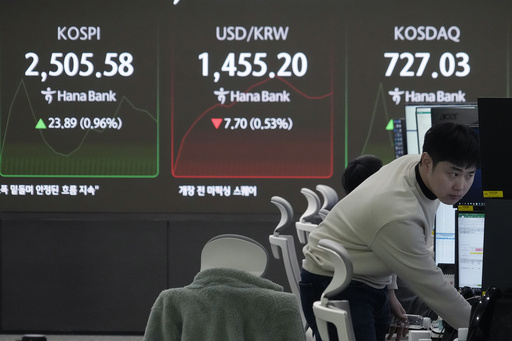
Asian stock markets displayed a mixed picture on Wednesday as investors assessed the potential ramifications of tariffs imposed by the United States and China.
The Nikkei 225 in Japan recovered from earlier declines, showing minimal change with a slight increase of less than 0.1%, reaching 38,820.77 during afternoon trading. Meanwhile, Australia’s S&P/ASX 200 saw a rise of 0.5%, climbing to 8,416.90. In contrast, the Hang Seng Index fell by 1.2%, settling at 20,543.93, and the Shanghai Composite Index dropped by 0.7% to 3,227.20. South Korea’s Kospi index, however, experienced a surge, rising 1.1% to 2,508.79 as investors seized opportunities after recent price declines, buoyed by optimism from gains seen on Wall Street overnight.
Some market analysts believe that the tariffs on China might be treated differently than other tariffs imposed during Trump’s presidency. They speculate that Trump may opt to maintain tariffs on China for an extended period, seeking to further estrange the U.S. from its geopolitical competitor.
The current tariff structure includes a 10% levy on goods imported from China by U.S. companies, which has been met with retaliatory strikes from China, including tariffs on specific U.S. products and launching an antitrust probe into Google.
Notably, China’s intended tariffs comprise a 15% tax on U.S. coal and liquefied natural gas, and a 10% tariff on crude oil, agricultural machinery, and large-engine vehicles originating from the United States. These new tariffs will take effect on the upcoming Monday, providing a short window for potential negotiations between President Trump and China’s President Xi Jinping.
Stephen Innes, managing partner at SPI Asset Management, warned that while trade tensions have not yet escalated to extreme levels, they are approaching a critical juncture, suggesting that those who underestimate these tensions do so at their peril.
On Wall Street, a sense of calm returned as technology stocks primarily led U.S. indices upward, supported by a favorable profit report from Palantir Technologies, which has thrived amid the artificial intelligence surge.
The S&P 500 index increased by 0.7%, rebounding after a sharp drop linked to concerns over how Trump’s tariffs might lead to a trade war, ultimately affecting global economies, including the U.S.
The Dow Jones Industrial Average gained 134 points, or 0.3%, while the Nasdaq composite rose by 1.4%.
Trump made headlines again on Monday, agreeing to postpone his tariffs on imports from Canada and Mexico, a move that bolstered long-standing optimism on Wall Street. This led to speculation that the administration may use tariffs more as negotiating tools rather than as permanent constraints.
Investors harbor hopes that Trump recognizes the adverse impact a long-term trade war would have on Wall Street, as he has previously highlighted stock market performance as a reflection of his presidency.
However, analysts caution that the possibility of a trade war remains looming, urging investors to take Trump’s threats seriously.
Bank of America strategists, led by Mark Cabana, emphasized the importance of investors treating the equity market as a metric for the U.S. administration’s performance and advised maintaining caution regarding any policy changes that might harm risk assets.
Despite the antitrust investigation facing it in China, the stock of Alphabet, Google’s parent company, experienced a rise of 2.5%.
Contrastingly, pharmaceutical giant Merck saw a significant decline of 9.1% despite surpassing sales and profit expectations in the latest quarter; the company’s revenue forecast fell below analysts’ forecasts, partly due to delays in shipments for one of its leading products to China.
Overall, the S&P 500 advanced by 43.31 points to close at 6,037.88, while the Dow Jones Industrial Average increased by 134.13 points to finish at 44,556.04. The Nasdaq composite gained 262.06 to reach 19,654.02.
In the bond market, U.S. Treasury yields softened following a report hinting that the job market may be exerting less pressure on inflation. Recent data indicated that U.S. job openings decreased more than economists had anticipated at the end of December, reflecting a slowing yet still robust job market.
The yield on the 10-year Treasury dipped to 4.51%, down from 4.56%, while the two-year yield, which is more correlated with Fed interest rate predictions, fell to 4.21% from 4.25%.
In energy sector trading, benchmark U.S. crude prices declined by 6 cents to $72.64 per barrel, while Brent crude, the international standard, saw a drop of 16 cents to $76.04 per barrel.
In forex markets, the U.S. dollar weakened against the Japanese yen, falling to 153.43 from 154.30 yen. The euro exchanged hands at $1.0378, a slight decrease from $1.0382.

